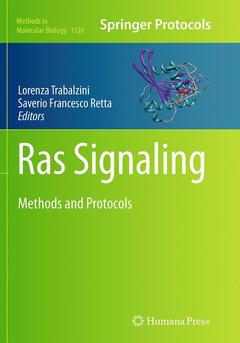Description
Ras Signaling, Softcover reprint of the original 1st ed. 2014
Methods and Protocols
Methods in Molecular Biology Series, Vol. 1120
Coordinators: Trabalzini Lorenza, Retta Saverio Francesco
Language: English
Subjects for Ras Signaling:
Publication date: 08-2016
Support: Print on demand
Publication date: 01-2014
425 p. · 17.8x25.4 cm · Hardback
Description
/li>Contents
/li>Comment
/li>
Featuring experimental approaches that shed light on the complexity of Ras GTPase biological functions, Ras Signaling: Methods and Protocols contains general overviews and detailed applications of both well-established and recently developed research techniques, including biochemical, biophysical, molecular biology, genetic and behavioral approaches, advanced high resolution fluorescence and electron microscopy imaging and ?omics? technologies. Through this, the detailed volume provides information on expression, post-translational modifications, subcellular localization and dynamics, regulatory mechanisms of upstream and downstream signaling pathways and ultimately, biological activities and functions of Ras GTPases in different model systems, including high and low eukaryotic organisms. Written in the highly successful Methods in Molecular Biology series format, chapters include brief introductions, lists of the necessary materials and reagents, step-by-step, readily reproducible laboratory protocols and tips on troubleshooting and avoiding known pitfalls.
Wide-ranging and authoritative, Ras Signaling: Methods and Protocols serves as an aid for investigators of different backgrounds and interests related to the multiple physiological and pathological functions of the large superfamily of Ras GTPases.
The Ras Superfamily of Small GTPases: The Unlocked Secrets.- A Novel Method for the Production of Fully-Modified K-Ras 4B.- Metabolic Labeling of Ras with Tritiated Palmitate to Monitor Palmitoylation and Depalmitoylation.- Ubiquitination of Rac1 by Inhibitors of Apoptosis (IAPs).- Ras GTPases are Both Regulators and Effectors of Redox Agents.- Biophysical and Proteomic Characterization Strategies for Cysteine Modifications in Ras GTPases.- Use of the Yeast Two-Hybrid Technology to Isolate Molecular Interactions of Ras GTPases.- Screening for MAPK Modulators Using an In-Cell Western Assay.- Behavioral Methods for the Study of the Ras-ERK Pathway in Memory Formation and Consolidation: Passive Avoidance and Novel Object Recognition Tests.- Functional Phosphoproteomics of Oncogenic KRAS Signaling.- Pull-Down Assay for Analysis of Integrin-Mediated Activation of Rap Proteins in Adherent Platelets.- Combined Pulldown and Time-Lapse Microscopy Studies for Determining the Role of Rap1 in the Crosstalk Between Integrins and Cadherins.- Fluorescence Microscopy Study of Rap1 Subcellular Localization.- An In Vitro System to Evaluate the Scaffold Function of the RalA Effector Protein RalBP1.- Analysis of the Rit Subfamily GTPase-Mediated Signaling and Neuronal Differentiation and Survival.- Immunofluorescence Methods in Studies of the GTPase RAN and Its Effectors in Interphase and in Mitotic Cells.- High Resolution Scanning Electron Microscopy for the Imaging of Nuclear Pore Complexes and Ran-Mediated Transport.- Effector Recruitment Method to Study Spatially Regulated Activation of Ras and Rho GTPases.- Real-Time Visualization and Quantification of Native Ras Activation in Single Living Cells.- Nanoclustering and Heterogeneous Membrane Diffusion of Ras Studied by FRAP and RICS Analysis.- Analyzing the Roles of Rho GTPases in Cancer Cell Migration with a Live Cell Imaging 3D-Morphology-Based Assay.- Analysis of Rho-GTPase-Induced Localization of Nanoscale AdhesionsUsing Fluorescence Nanoscopy.- Yeast as a Model for Ras Signaling.- Methods to Study the Ras2 Protein Activation State and the Subcellular Localization of Ras-GTP in Saccharomycescerevisiae.- RAS Proteins Signaling in the Early Metazoan Dictyostelium discoideum.




